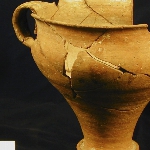Cup
MS4169
From: Greece | Crete | Gournia
Curatorial Section: Mediterranean
| Object Number | MS4169 |
| Current Location | Collections Storage |
| Culture | Minoan |
| Provenience | Greece | Crete | Gournia |
| Period | Late Minoan IB |
| Section | Mediterranean |
| Materials | Ceramic |
| Description | Stemmed cup (a tall semiglobular cup, piriform, with one strap handle); small hole in base; rivet-like pellet on handle at point where it joins the rim. Medium textured, light red (2.5 YR 4/6) to black paint, added red (poorly preserved) paint. Wiped with water and burnished. Band on inside of rim; bands on rim and lower body, with base painted solid; frieze of double axes with pairs of dots between them on shoulder; bottom of base unpainted. Added red: bands below the frieze. Added white: thin bands on the dark bands on the rim, lower body, and base. Restored from fragments; some sherds missing. This shape, with a small hole in the base, would have made a good container for growing plants. An alternative possibility is a use as a rhyton. The type is fairly common in eastern Crete. Examples with friezes of double axes include (among others) Hawes et al. 1908: pl.8, no. 26 (Gournia); Bosanquet and Dawkins 1923: 34, nos. HM 3265 and 1523 (Palaikastro). For other examples of the shape see Dawkins 1903: fig. 17 (Zakros); 1902-1903: 314, fig. 12, no. 1 (Palaikastro); Bosanquet and Dawkins 1923: pl. 17b, and p. 34, with a list of nine others (Palaikastro); Pernier and Banti 1951: 271-275, fig. 171 (Phaistos). The motif is discussed by Niemeier 1980: 29 and fig. 10; 1985: 116-120 and fig. 57. |
| Height | 13.8 cm |
| Outside Diameter | 14.4 cm |
| Credit Line | Gift of the Candia Museum (Herakleion Archaeological Museum); H. B. Hawes, 1904 |
Report problems and issues to digitalmedia@pennmuseum.org.



